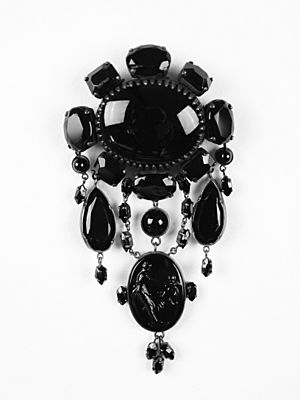Jet (lignite) facts for kids

Jet is a special type of lignite, which is like a very early form of coal. It's considered a gemstone, even though it's not a mineral. Instead, it's called a mineraloid. This means it comes from living things, specifically from wood that has decayed and been under huge pressure for a very long time.
The word "jet" comes from the French word "jais." Jet is usually black or very dark brown. Sometimes, it has shiny, brass-colored spots called pyrite inclusions. These spots have a metallic shine. The phrase "jet-black," meaning the darkest black possible, comes from this material.
Where Does Jet Come From?
Jet forms from wood that broke down millions of years ago under high pressure. This wood often came from trees like those in the Araucariaceae family. Jet is found in two main types: hard jet and soft jet. Hard jet forms when carbon from the wood is pressed together with salt water. Soft jet forms when carbon is pressed together with fresh water.
The jet found in Whitby, England, is very old. It formed about 182 million years ago during the early Jurassic period. This Whitby Jet comes from fossilized wood of trees similar to the modern Chile pine, also known as the Monkey Puzzle tree (Araucaria araucana).
You can also find jet in other places around the world. These include Poland, Santiago de Compostela in northern Spain, and near Erzurum in Turkey. In Turkey, jet is often used to make prayer beads.
A Look Back: Jet Through History
People in Britain have used jet since the Stone Age. However, the oldest known jet object is a tiny model of a botfly larva, found in Germany, which is about 12,000 years old. In Britain, jet was popular during the Bronze Age for making beads for necklaces.
During the Iron Age, jet wasn't as popular. But it became fashionable again in Roman Britain around 200 AD. When the Romans left Britain, jet's popularity faded again. Even though it was still used in the Anglo-Saxon and Viking times, and later in the Middle Ages, it wasn't widely loved. Jet made a big comeback during the Victorian era, especially for mourning jewelry.
Images for kids
-
Three views of a prehistoric pendant made of lignite/jet. It's from the Magdalenian culture (17,000–10,000 BCE) and was found in the Marsoulas cave in Marsoulas, Haute-Garonne, France.
-
A jet carving (cameo) showing a Medusa in the Yorkshire Museum.
See also
 In Spanish: Azabache para niños
In Spanish: Azabache para niños





